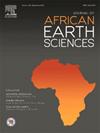Diagenesis of the Callovian-Kimmeridgian Antalo Limestone Formation, Blue Nile Basin, Ethiopia: Implications for characterizing hydrocarbon reservoir quality
IF 2.2
4区 地球科学
Q2 GEOSCIENCES, MULTIDISCIPLINARY
引用次数: 0
Abstract
Understanding the diagenetic evolution of carbonate formations is essential for evaluating their reservoir potential. This study provides the first integrated analysis of the diagenetic process affecting the reservoir quality of the Callovian-Kimmeridgian Antalo Limestone Formation in the Blue Nile Basin. Extensive field investigations, including detailed section logging and rock sample collection, were conducted across the Dejen-Gohatsion traverse, Jemma, and Mugher areas. From the collected rock samples, 115 representative samples were selected for petrographic analysis to assess the key diagenetic processes controlling porosity and reservoir quality of the carbonate deposits. The analysis reveals that calcite cementation and dissolution are the most prominent porosity-reducing and enhancing diagenetic processes, respectively. Other processes such as compaction, dolomitization, silicification, bioturbation, micritization, and fracturing diagenetic processes have significantly influenced primary and secondary porosity development, and reservoir quality of the Antalo Limestone Formation. This study provides insight into the Antalo Limestone reservoir quality in the Blue Nile Basin. Moreover, it offers important baseline data to guide future exploration and advanced investigations aimed at re-evaluating the formation as a significant reservoir. It also enhances the current understanding of reservoir heterogeneity in Ethiopian Jurassic carbonates and contributes valuable insights for regional hydrocarbon exploration.
埃塞俄比亚青尼罗盆地卡洛纪-基默里吉纪Antalo灰岩组成岩作用及其对油气储层质量的指示意义
了解碳酸盐岩地层的成岩演化对评价其储层潜力至关重要。该研究首次综合分析了青尼罗盆地卡洛纪—基默里吉纪安塔洛灰岩组成岩作用对储层质量的影响。广泛的实地调查,包括详细的剖面测井和岩石样本收集,在dejengohatsion、Jemma和Mugher地区进行。从收集到的岩石样品中,选取了115个具有代表性的样品进行岩石学分析,以评价控制碳酸盐矿床孔隙度和储层质量的关键成岩作用。分析表明,方解石胶结作用和溶蚀作用分别是最显著的减孔和增孔成岩作用。压实作用、白云石化作用、硅化作用、生物扰动作用、泥晶化作用、压裂成岩作用等作用对安塔洛灰岩组原生和次生孔隙发育及储层质量均有显著影响。这项研究为了解青尼罗河盆地的Antalo石灰岩储层质量提供了新的思路。此外,它还提供了重要的基线数据,以指导未来的勘探和进一步的调查,旨在将该地层重新评价为重要的储层。它还增强了目前对埃塞俄比亚侏罗纪碳酸盐岩储层非均质性的认识,并为区域油气勘探提供了有价值的见解。
本文章由计算机程序翻译,如有差异,请以英文原文为准。
求助全文
约1分钟内获得全文
求助全文
来源期刊

Journal of African Earth Sciences
地学-地球科学综合
CiteScore
4.70
自引率
4.30%
发文量
240
审稿时长
12 months
期刊介绍:
The Journal of African Earth Sciences sees itself as the prime geological journal for all aspects of the Earth Sciences about the African plate. Papers dealing with peripheral areas are welcome if they demonstrate a tight link with Africa.
The Journal publishes high quality, peer-reviewed scientific papers. It is devoted primarily to research papers but short communications relating to new developments of broad interest, reviews and book reviews will also be considered. Papers must have international appeal and should present work of more regional than local significance and dealing with well identified and justified scientific questions. Specialised technical papers, analytical or exploration reports must be avoided. Papers on applied geology should preferably be linked to such core disciplines and must be addressed to a more general geoscientific audience.
 求助内容:
求助内容: 应助结果提醒方式:
应助结果提醒方式:


